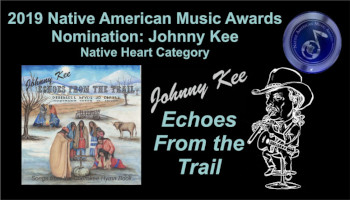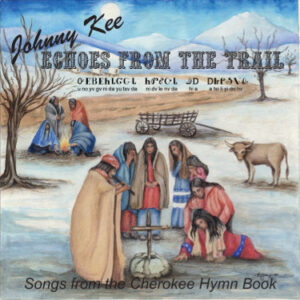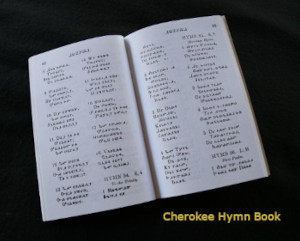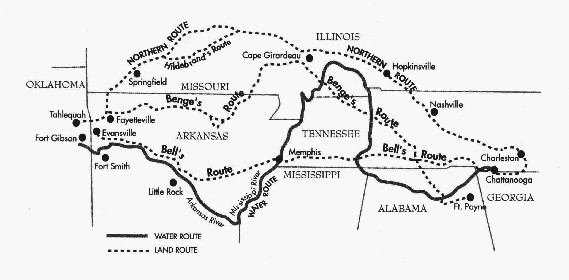Echoes From the Trail
Over 2 1/2 years in the works, Johnny Kee’s first commercial CD was finally released in October, 2018. Historically, the first book published in the Cherokee syllabary (written language) was the Cherokee Hymn Book, published in 1829. This book was available for nearly a decade when the U.S. Army forced the Cherokee people out of their homes and onto the Trail of Tears in 1838-1839. By the time of the “removal”, many Cherokee had converted to Christianity. I have heard that songs from the Hymn Book, especially Hymn 87 to the tune of Amazing Grace, were heard many times along the trail. This CD represents Johnny Kee’s interpretations of a dozen of the songs from the Hymn Book.

My CD, Echoes From the Trail, was honored with a
Native American Music Awards (NAMA) nomination!
I was fortunate to get my start in playing guitar and singing during the so-called folk music revival of the late ’50s into the ’60s. My inclination from the beginning was to do folk songs, including hymns, spirituals, and old time gospel music. Thanks to a heritage project in junior high school, I learned of my family history going back to John Kee, who traveled the “northern route” of the Trail of Tears with his family. But the Kees “deserted” the trail in southwestern Missouri when his mother became deathly ill. My mother’s side of the family (her mother was John Kee’s granddaughter) settled in and around Springfield, where both my mother and I were born. So this CD has been a personal journey into my family’s past through my music. Today I sing some of these same hymns and gospel songs (in English of course) in our church Praise Band.

Echoes From the Trail

The “removal” of the Cherokee people from their homelands in the east to Indian Territory nearly a thousand miles away in 1838-1839 fulfilled a promise to the people of Georgia by President Jackson, and is part of the reason that President Jefferson made the Louisiana Purchase from France – to have lands west of the Mississippi River to relocate Native peoples of the 5 “civilized tribes” (the Cherokee, Chickasaw, Choctaw, Muskogee (Creek), and Seminoles) to. The “removal” was especially brutal for the Cherokee, with an estimated 4000, 1/4 of the Cherokee people relocated, dying either in the stockades or along the trail of disease, exposure, or starvation, giving this historic tragedy the name we know it by, the Trail of Tears.
By the time of the “removal”, many of the Cherokee had converted to Christianity, as the first European visitors to Cherokee country were traders and missionaries. The first book published in the Cherokee syllabary (written language characters) was the Cherokee Hymn Book, published in 1829. It is said that the hymns from the Hymn Book, and especially Amazing Grace, were heard many times along the trail, often at scenes like the one depicted in Joyce Bugaiski’s beautiful cover art.
Learn more about the Cherokee Hymn Book and the Trail of Tears below.
Track
Preview
Back Story
Track Title & Description
1
Hymn 128 (tune: In the Sweet By and By) In the Cherokee lyrics, this is a hymn of baptism, beginning with the story of Jesus being baptized in the River Jordan. The final verse asks for beautiful songs to play for Jesus.
2
Hymn 134 (tune: Old Rugged Cross) The Cherokee lyrics are a call for soldiers of the cross to arise, along the lines of the Battle Hymn of the Republic in English.
3
Hymn 142 (tune: Leaning On the Everlasting Arms) This is a temperance song in Cherokee, with each verse and chorus ending with a variation on “Don’t touch it.”
4
Hymn 38 (tune: Nearer My God to Thee) This Cherokee hymn calls us to “come humble sinner” and trust in the One who lives above.
5
Hymn 87 (tune: Just a Closer Walk With Thee) This is my personal interpretation of Hymn 87 and not a tune found in the Hymn Book. Hymn 87 is best known sung to the tune of Amazing Grace (track 11 on this CD).
6
Hymn 94 (tune: My Faith Looks Up to Thee) The Cherokee in this hymn praises the trinity.
7
Hymn 93 (tune: Rock of Ages) The Cherokee lyrics are 18 verses long, and tells a detailed story of the crucifixion and resurrection. I have chosen 6 verses that capture the key points of the story.
8
Hymn 39 (tune: I’ll Fly Away) The Cherokee version tells of a call for we sinners to come to Jesus. [This song is licensed for use on this CD.]
9
Hymn 17 (tune: What a Friend We Have in Jesus) The Cherokee lyric raises praise and love to Jehovah (yi-ho-wa in Cherokee, the first words of the first verse).
10
Hymn 35 (tune: Silent Night) It may be difficult to listen to this and not think of the Christmas carol, but the Cherokee lyrics have nothing to do with that holiday. The Cherokee lyrics tell of finding peace in Jesus Christ. The original has 7 verses, from which I chose 2.
11
Hymn 87 (tune: Amazing Grace) I learned at a Cherokee spirituality seminar many years ago in Cherokee, NC that this song is a kind of unofficial Cherokee national anthem. It is almost universally known among the Cherokee, but it is not a translation of the English Amazing Grace. It’s main theme is Christ’s second coming.
12
Hymn 9 (tune: Softly and Tenderly) The Cherokee lyrics for this song are based on Psalm 146, honoring and praising God for His help.
Acknowledgements
I wish to acknowledge the help I’ve received from some very talented people. First, there were Annette Abbondanza (Painted Raven) and Ken Holt (Who I Am) who have critiqued and offered suggestions for all of the tracks as I completed initial mixes. Their fine ear and experience in producing and recording CDs of their own have been invaluable. I really appreciate Randy McGinnis, Native American Music Association 2017 Flutist of the Year, for translating “Echoes From the Trail” into Cherokee for the CD cover. And, my special gratitude to Joyce Bugaiski, a very talented artist and dear friend, for the beautiful art that graces the jacket of this CD. Her scenes set the mood for the music on the CD. Finally, I appreciate my wife, Claire, for her support and understanding when I get wrapped up in projects like this.
 The Cherokee Hymn Book
The Cherokee Hymn Book
In 1821 a Cherokee they called Sequoyah presented a proposal to the tribal council for a way to write the Cherokee language. He had worked on this idea alone for a decade, and ended up using symbols to represent syllables rather than letters as in English and other European languages. His invention is therefore called the Cherokee syllabary, and in 1821 the tribal council accepted it.
The people quickly adopted the new syllabary and it wasn’t long before the literacy rate among the Cherokee in their new writing system was higher than that in Georgia in general. In 1825 the Cherokee secured a printing press with the new syllabary typeset, and in 1828 began publishing a bi-lingual Cherokee/English newspaper called the Cherokee Phoenix. In 1829 the first book in the syllabary was published, the Cherokee Hymn Book.
The first Hymn Book, and versions through the 2014 republication, contained only the lyrics in the syllabary, with no indication of a tune. The 2014 version added the name of an English hymn or gospel song as a tune to go with the lyrics. The 2014 version also added the phonetic pronunciation of the Cherokee and an English translation. Again, the hymn’s Cherokee lyrics are not a translation of the English lyrics of the identified song, but a new Cherokee lyric with a meaning unrelated to the English. For example, Hymn 35 is sung to the tune of Silent Night, but is not a Christmas song.
The Cherokee Hymn Book may be purchased from the Museum of the Cherokee Indian museum store in Cherokee, NC.
In 1835, a treaty was signed between former tribal leaders with no authority to speak for the Cherokee people and the U.S. Government that called for the “removal” of all Cherokee in the east within 2 years. The treaty was ratified by the U.S. Senate (by just 1 vote) in 1836. When the people did not voluntarily leave their lands under what they considered an illegal treaty, in 1838 the U.S. Army rounded up the people and forced them into hastily constructed stockades, from which they were later forced to walk to new lands in Indian Territory (today’s eastern Oklahoma), mostly during the brutal winter of 1838-1839. In the stockades and along their journey, approximately 4000, or 1/4 of the 16,000 people, died, giving the “removal” the name we know it by today, the “Trail of Tears.”

By the time of the “removal”, many of the Cherokee had converted to Christianity. Missionaries moved among the people while they were in the stockades, converting others, and accompanied them on the trail. Deaths, primarily among the very young and the very old, were daily occurrences. Principal Chief John Ross’s own wife died when she gave up her blanket to a child. It is said that the hymns in the Hymn Book, and especially Hymn 87 to the tune of Amazing Grace, were heard many times along the trail. The group did not stop for the hasty burials along the side of the road, so the mourners had to catch up after their brief grieving at the graveside, the image in Joyce Bugaiski’s beautiful cover art for this CD.
The Trail of Tears National Historic Trail was established by an act of Congress in 1987. It’s dedicated to identifying and preserving sites associated with the removal of Native Americans from the southeastern United States. The Trail of Tears Association (TOTA) was created to support the Historic Trail. There are nine TOTA chapters representing the nine states that the Cherokee and other tribes traveled through on their way to Indian Territory.
